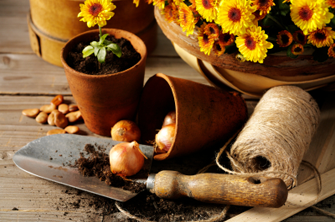
| Enjoy a glass of soy milk as you do your gardening. |
Essential Fall Gardening Tips to Get a Head Start Next Spring
Although it’s tempting to sit back and watch Mother Nature work her magic, there are a few fall gardening tasks that are essential if you want to keep your gardens in good condition for the following spring. Fall is the right time to do some tidy up, maintenance and planting for the spring season up ahead.
1 – Garden Upkeep
Pick up or rake dead leaves from underneath your rose bushes and crab apple trees, and clean the debris from your summer annuals and perennials. Clean up as much as possible since, if left alone, these bits and pieces will infuse your plants with disease spores the following spring.
2 – Avoid Burlap Coats
Many think it is a good idea to wrap their plants, shrubs and trees with burlap to protect them from the winter weather. In fact, this only does them more harm than good since this wrap can hold ice against their tissues. If you must protect your plants from wind during the winter, set up barriers using burlap and stakes around the area, and fasten the structure with large pins to break the powerful air currents.
3 – Anti-Transpirant Sprays
On your needle and broadleaf evergreens, use anti-transpirant sprays. This spray creates a waxy coating that helps to preserve the moisture in the tissue, while preventing windburn and sun scalding.
4 – Planting
Plant your favourite tulips, daffodils, crocuses and snowdrops. It is important that you plant them deep into the ground before hard frosts hit and be sure to choose larger bulbs for bigger flowers. Make sure your soil is well drained and plant them about six weeks before the soil freezes. A key tip: plant the bulbs pointy side up and as deep as three times their height. If you can’t identify a pointy side, plant the bulb sideways and it will correct itself when it comes time to grow above ground.
Fall is also a great time to plant perennials. When planted in the fall, perennials have enough time to establish their roots. Those that do especially well in the fall include irises, peonies and lilies.
5 – Mulching
Wait until after you’ve planted your autumn flowers and shrubs before you mulch your soil. It’s a good idea to pour a thick layer of mulch consisting of leaves and evergreen cuttings – particularly over the root balls you’ve just planted. You may also want to consider pouring leaves (honeylocust, birch, beech, ginkgo, or silver maple) under your shrubs and over all of your soil. Leaves break down into healthy minerals which worms then turn into fertilizer that is excellent food for your plants.
6 – Raking
If you can, rake and remove leaves from your lawn on a weekly basis in the fall. Your grass needs sunlight in the fall in order to grow strong the following spring.
7 – For the Garlic Lovers
If you cook with a lot of garlic, consider growing your own. Fall is the perfect time to plant it – October, in particular – in a place with lots of sunshine and be sure to dig it into the ground along with manure. Each clove should be planted eight centimetres deep and 15 centimetres apart from other cloves. Add a mulch of leaves on top. Expect your garlic harvest in July.
Make your spring gardening more pleasurable and a greater success by following these suggestions. Fall is a great time to plan your garden for next spring and to protect what you’ve already created before winter hits.

